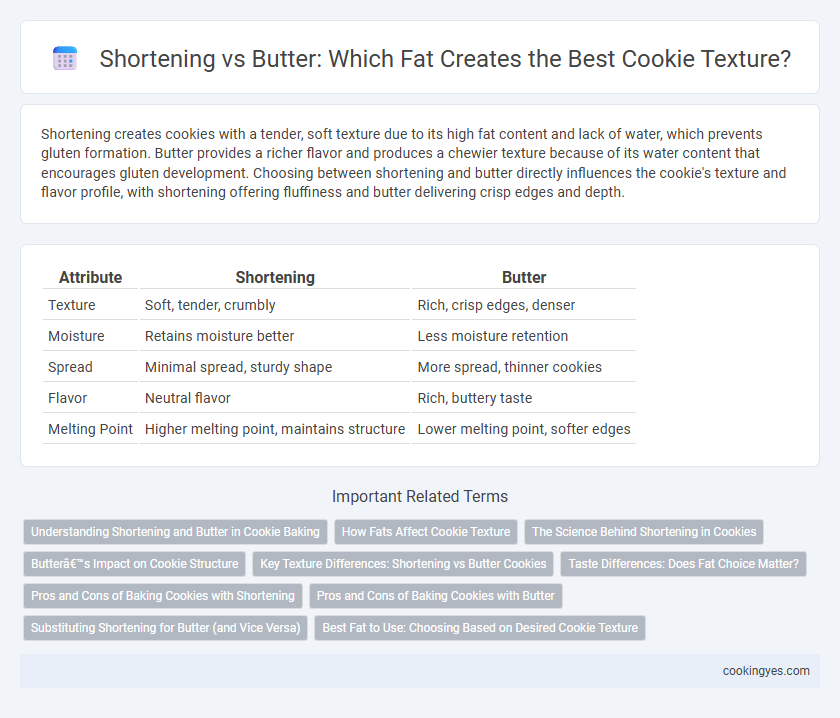Shortening creates cookies with a tender, soft texture due to its high fat content and lack of water, which prevents gluten formation. Butter provides a richer flavor and produces a chewier texture because of its water content that encourages gluten development. Choosing between shortening and butter directly influences the cookie's texture and flavor profile, with shortening offering fluffiness and butter delivering crisp edges and depth.
Table of Comparison
| Attribute | Shortening | Butter |
|---|---|---|
| Texture | Soft, tender, crumbly | Rich, crisp edges, denser |
| Moisture | Retains moisture better | Less moisture retention |
| Spread | Minimal spread, sturdy shape | More spread, thinner cookies |
| Flavor | Neutral flavor | Rich, buttery taste |
| Melting Point | Higher melting point, maintains structure | Lower melting point, softer edges |
Understanding Shortening and Butter in Cookie Baking
Shortening is a solid fat made from vegetable oils that creates tender, soft cookies by inhibiting gluten formation and retaining moisture, resulting in a higher rise and less spread. Butter, composed of about 80% fat and 20% water, adds rich flavor and contributes to a crisper edge and chewier center due to its water content promoting steam during baking. Choosing between shortening and butter directly affects cookie texture, with shortening yielding softer, cakier results and butter providing depth of flavor and a firmer, more textured bite.
How Fats Affect Cookie Texture
Fats play a crucial role in determining cookie texture, with shortening producing softer, more tender cookies due to its 100% fat content and lack of water. Butter, containing about 80% fat and some water, contributes to cookies that are crisper and have a richer flavor but can lead to spreading because of water content turning to steam during baking. The choice between butter and shortening affects moisture retention, spread rate, and overall mouthfeel, making fat type a key factor in cookie texture optimization.
The Science Behind Shortening in Cookies
Shortening contains 100% fat with no water content, which inhibits gluten formation and results in a tender, crumbly cookie texture. Its higher melting point compared to butter allows cookies to hold their shape better during baking, producing a soft interior with slightly crisp edges. The lack of water in shortening prevents steam production, reducing spread and contributing to a uniform, thick cookie structure.
Butter’s Impact on Cookie Structure
Butter's unique composition, containing about 80% fat and water, significantly influences cookie texture by promoting a tender yet structured crumb. The water content in butter encourages gluten development during baking, contributing to a chewier, slightly denser cookie compared to the softer texture produced by shortening. Additionally, butter's milk solids enhance browning and flavor complexity, resulting in cookies with a richer taste and firmer edges.
Key Texture Differences: Shortening vs Butter Cookies
Shortening creates cookies with a tender, soft texture and a higher rise due to its 100% fat content and lack of water. Butter-based cookies offer a richer flavor and slightly denser texture with crisp edges, benefiting from butter's water that causes steam and spreading. Choosing shortening results in lighter, fluffier cookies, while butter provides a more complex taste and firmer bite.
Taste Differences: Does Fat Choice Matter?
Shortening creates cookies with a tender, soft texture and a neutral taste that enhances other flavors without adding richness. Butter imparts a rich, creamy flavor and a slightly crisp edge due to its water content, resulting in a more complex, buttery taste profile. Choosing between shortening and butter significantly affects cookie flavor and texture, making it an essential consideration for bakers aiming for specific taste experiences.
Pros and Cons of Baking Cookies with Shortening
Baking cookies with shortening produces a tender, softer texture due to its high melting point, which prevents cookies from spreading too much. Shortening contains no water, enhancing shelf life and maintaining moisture better than butter, but it lacks the rich flavor that butter imparts. Cookies made with shortening tend to have a more uniform texture and hold their shape well but may taste less complex compared to butter-based cookies.
Pros and Cons of Baking Cookies with Butter
Baking cookies with butter enhances flavor and creates a rich, aromatic profile due to its natural milk solids and water content, which promote browning and crisp edges. However, butter's lower melting point compared to shortening can cause cookies to spread more, resulting in thinner, less uniform shapes. Despite this, butter-based cookies often achieve a tender, melt-in-your-mouth texture that is preferred for traditional recipes.
Substituting Shortening for Butter (and Vice Versa)
Substituting shortening for butter in cookies results in a softer, more tender texture due to shortening's higher fat content and lack of water. Using butter instead of shortening provides a richer flavor and a crisper edge but may yield a slightly denser cookie because of its water content. Adjustments in baking time and ingredient ratios help achieve the desired cookie texture when swapping between these fats.
Best Fat to Use: Choosing Based on Desired Cookie Texture
Choosing the best fat for cookies depends on the desired texture: shortening creates tender, soft, and thicker cookies due to its 100% fat content and lack of water, which inhibits gluten formation. Butter, containing about 80% fat and some water, produces cookies with a richer flavor, crisper edges, and a chewier texture. For soft, cake-like cookies, shortening is preferred, while butter is ideal for those seeking flavorful, crisp-tender cookies.
Shortening vs Butter for Cookie Texture Infographic

 cookingyes.com
cookingyes.com